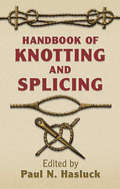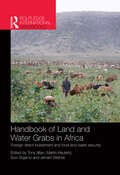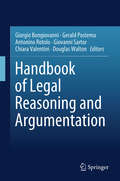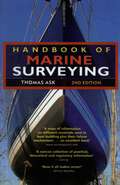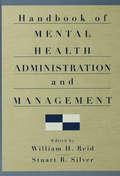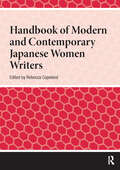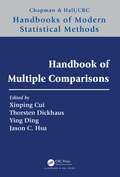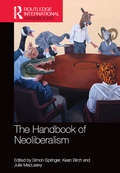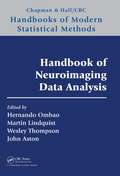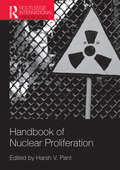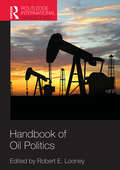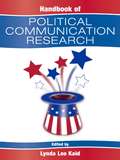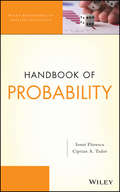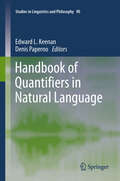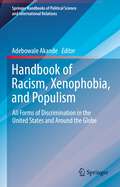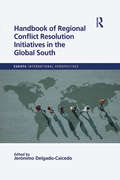- Table View
- List View
Handbook of Knotting and Splicing (Dover Maritime Series)
by Paul N. HasluckGenerations of scouts and sailors have learned their lore from this classic reference by a master craftsman. Editor Paul N. Hasluck was a renowned contributor to numerous technical journals as well as the author of several books on crafts and antiques. His clearly written guide--amply illustrated with 208 figures--dates from the turn of the twentieth century and offers timeless instruction for knotters and splicers of ropes.Starting with simple and useful knots, this manual proceeds to more complex varieties: eye knots, hitches, and bends; ring knots and rope shortenings; ties and lashings; and fancy knots. Additional topics include rope splicing; working cordage; hammock making; lashings and ties for scaffolding; and splicing and socketing wire ropes. A helpful index appears at the end, and a list of illustrations identifies the figures in order of appearance.
Handbook of Land and Water Grabs in Africa: Foreign direct investment and food and water security (Routledge International Handbooks Ser.)
by Tony Allan Jeroen Warner Martin Keulertz Suvi SojamoAccording to estimates by the International Land Coalition based at the International Fund for Agricultural Development (IFAD), 57 million hectares of land have been leased to foreign investors since 2007. Current research has focused on human rights issues related to inward investment in land but has been ignorant of water resource issues and the challenges of managing scarce water. This handbook will be the first to address inward investment in land and its impact on water resources in Africa. The geographical scope of this book will be the African continent, where land has attracted the attention of risk-taking investors because much land is under-utilised marginalized land, with associated water resources and rapidly growing domestic food markets. The successful implementation of investment strategies in African agriculture could determine the future of more than one billion people. An important factor to note is that Sub-Saharan Africa will, of all the continents, be hit hardest by climate change, population growth and food insecurity. Sensible investment in agriculture is therefore needed, however, at what costs and at whose expense? The book will also address the livelihoods theme and provide a holistic analysis of land and water grabbing in Sub-Saharan Africa. Four other themes will addressed: politics, economics, environment and the history of land investments in Sub-Saharan Africa. The editors have involved a highly diverse group of around 25 expert researchers, who will review the pro and anti-investment arguments, geopolitics, the role of capitalist investors, the environmental contexts and the political implications of, and reasons for, leasing millions of hectares in Sub-Saharan Africa. To date, there has been no attempt to review land investments through a suite of different lenses, thus this handbook will differ significantly from existing research and publication. The editors are Tony Allan, (Professor Emeritus, Department of Geography, School of Oriental and African Studies and King’s College London); Jeroen Warner (Assistant Professor, Disaster Studies, University of Wageningen); Suvi Sojamo (PhD Researcher, Water and Development Research Group, Aalto University); and Martin Keulertz (PhD Researcher, Department of Geography, London Water Group, King’s College London).
Handbook of Legal Reasoning and Argumentation
by Douglas Walton Giovanni Sartor Antonino Rotolo Giorgio Bongiovanni Gerald Postema Chiara ValentiniThis handbook addresses legal reasoning and argumentation from a logical, philosophical and legal perspective. The main forms of legal reasoning and argumentation are covered in an exhaustive and critical fashion, and are analysed in connection with more general types (and problems) of reasoning. Accordingly, the subject matter of the handbook divides in three parts. The first one introduces and discusses the basic concepts of practical reasoning. The second one discusses the general structures and procedures of reasoning and argumentation that are relevant to legal discourse. The third one looks at their instantiations and developments of these aspects of argumentation as they are put to work in the law, in different areas and applications of legal reasoning.
Handbook of Local and Regional Development
by Andy PikeThe Handbook of Local and Regional Development provides a comprehensive statement and reference point for local and regional development. The scope of this Handbook’s coverage and contributions engages with and reflects upon the politics and policy of how we think about and practise local and regional development, encouraging dialogue across the disciplinary barriers between notions of ‘local and regional development’ in the Global North and ‘development studies’ in the Global South. This Handbook is organized into seven inter-related sections, with an introductory chapter setting out the rationale, aims and structure of the Handbook. Section one situates local and regional development in its global context. Section two establishes the key issues in understanding the principles and values that help us define what is meant by local and regional development. Section three critically reviews the current diversity and variety of conceptual and theoretical approaches to local and regional development. Section four address questions of government and governance. Section five connects critically with the array of contemporary approaches to local and regional development policy. Section six is an explicitly global review of perspectives on local and regional development from Africa, Asia-Pacific, Europe, Latin America and North America. Section seven provides reflection and discussion of the futures for local and regional development in an international and multidisciplinary context. With over forty contributions from leading international scholars in the field, this Handbook provides critical reviews and appraisals of current state-of-the-art conceptual and theoretical approaches and future developments in local and regional development.
Handbook of Marine Surveying
by Thomas AskThis expanded and updated edition of Thomas Ask&’s Handbook of Marine Surveying will be welcomed by students of marine surveying, professional marine surveyors, boatyard operators and technically-minded boat owners. It covers the latest surveying technology, including an analysis of the mechanical behavior of materials, stress concentration, failure analysis, fatigue an fracture, corrosion, wood-damaging organisms, the composition and characteristics of common plastics, metals and composite materials.New sections include: hull and deck loads, non-destructive testing, combustion and pollution, hydraulic and pneumatic systems, engine installations, fuel systems, electrical systems, piping and lubrication systems, HVAC/R systems, firefighting systems, noise and vibration, and propellers.There is also a useful survey checklist that provides practical techniques and hints for conducting a survey.
Handbook of Mathematical Functions: with Formulas, Graphs, and Mathematical Tables
by Milton Abramowitz Irene A. StegunDespite the increasing use of computers, the basic need for mathematical tables continues. Tables serve a vital role in preliminary surveys of problems before programming for machine operation, and they are indispensable to thousands of engineers and scientists without access to machines. Because of automatic computers, however, and because of recent scientific advances, a greater variety of functions and a higher accuracy of tabulation than have been available until now are required.In 1954, a conference on mathematical tables, sponsored by M.I.T. and the National Science Foundation, met to discuss a modernization and extension of Jahnke and Emde's classical tables of functions. This volume, published 10 years later by the U.S. Department of Commerce, is the result. Designed to include a maximum of information and to meet the needs of scientists in all fields, it is a monumental piece of work, a comprehensive and self-contained summary of the mathematical functions that arise in physical and engineering problems.The book contains 29 sets of tables, some to as high as 20 places: mathematical constants; physical constants and conversion factors (6 tables); exponential integral and related functions (7); error function and Fresnel integrals (12); Bessel functions of integer (12) and fractional (13) order; integrals of Bessel functions (2); Struve and related functions (2); confluent hypergeometric functions (2); Coulomb wave functions (2); hypergeometric functions; Jacobian elliptic and theta functions (2); elliptic integrals {9); Weierstrass elliptic and related functions; parabolic cylinder functions {3); Mathieu functions (2); spheroidal wave functions (5); orthogonal polynomials (13); combinatorial analysis (9); numerical interpolation, differentiation and integration (11); probability functions (ll); scales of notation (6); miscellaneous functions (9); Laplace transforms (2); and others.Each of these sections is prefaced by a list of related formulas and graphs: differential equations, series expansions, special functions, and other basic relations. These constitute an unusually valuable reference work in themselves. The prefatory material also includes an explanation of the numerical methods involved in using the tables that follow and a bibliography. Numerical examples illustrate the use of each table and explain the computation of function values which lie outside its range, while the editors' introduction describes higher-order interpolation procedures. Well over100 figures illustrate the text.In all, this is one of the most ambitious and useful books of its type ever published, an essential aid in all scientific and engineering research, problem solving, experimentation and field work. This low-cost edition contains every page of the original government publication.
Handbook of Mental Health Administration and Management
by Mph William H. Reid Stuart B. SilverClinicians who understand mental health care administration in addition to their clinical fields are likely to be valuable to the organizations in which they work. This handbook is an accessible source of information for professionals coming from either clinical or management backgrounds. Sections offer coverage in: mental health administrative principles, mental health care management, business, finance and funding of care, information technology, human resources and legal issues.
Handbook of Modern and Contemporary Japanese Women Writers (Handbooks on Japanese Studies)
by Rebecca CopelandThe Handbook of Modern and Contemporary Japanese Women Writers offers a comprehensive overview of women writers in Japan, from the late 19th century to the early 21st. Featuring 24 newly written contributions from scholars in the field—representing expertise from North America, Europe, Japan, and Australia—the Handbook introduces and analyzes works by modern and contemporary women writers that coalesce loosely around common themes, tropes, and genres. Putting writers from different generations in conversation with one another reveals the diverse ways they have responded to similar subjects. Whereas women writers may have shared concerns—the pressure to conform to gendered expectation, the tension between family responsibility and individual interests, the quest for self-affirmation—each writer invents her own approach. As readers will see, we have writers who turn to memoir and autobiography, while others prefer to imagine fabulous fictional worlds. Some engage with the literary classics—whether Japanese, Chinese, or European—and invest their works with rich intertextual allusions. Other writers grapple with colonialism, militarism, nationalism, and industrialization. This Handbook builds a foundation which invites readers to launch their own investigations into women’s writing in Japan.
Handbook of Motivation at School (Educational Psychology Handbook)
by Edited by Kathryn R. Wentzel and David B. MieleThe second edition of the Handbook of Motivation at School presents an integrated compilation of theory and research in the field. With chapters by leading experts, this book covers the major theoretical perspectives in the field as well as their application to instruction, learning, and social adjustment at school. Section I focuses on theoretical perspectives and major constructs, Section II on contextual and social influences on motivation, and Section III on new directions in the field. This new edition will have the same popular organizational structure with theories at the beginning. It will also include new chapters that cover motivation as it relates to identity, culture, test anxiety, mindfulness, neuroscience, parenting, metacognition, and regulatory focus.
Handbook of Multiple Comparisons (Chapman & Hall/CRC Handbooks of Modern Statistical Methods)
by Xinping Cui, Thorsten Dickhaus, Ying Ding, Jason C. HsuWritten by experts that include originators of some key ideas, chapters in the Handbook of Multiple Testing cover multiple comparison problems big and small, with guidance toward error rate control and insights on how principles developed earlier can be applied to current and emerging problems. Some highlights of the coverages are as follows. Error rate control is useful for controlling the incorrect decision rate. Chapter 1 introduces Tukey's original multiple comparison error rates and point to how they have been applied and adapted to modern multiple comparison problems as discussed in the later chapters. Principles endure. While the closed testing principle is more familiar, Chapter 4 shows the partitioning principle can derive confidence sets for multiple tests, which may become important as the profession goes beyond making decisions based on p-values. Multiple comparisons of treatment efficacy often involve multiple doses and endpoints. Chapter 12 on multiple endpoints explains how different choices of endpoint types lead to different multiplicity adjustment strategies, while Chapter 11 on the MCP-Mod approach is particularly useful for dose-finding. To assess efficacy in clinical trials with multiple doses and multiple endpoints, the reader can see the traditional approach in Chapter 2, the Graphical approach in Chapter 5, and the multivariate approach in Chapter 3. Personalized/precision medicine based on targeted therapies, already a reality, naturally leads to analysis of efficacy in subgroups. Chapter 13 draws attention to subtle logical issues in inferences on subgroups and their mixtures, with a principled solution that resolves these issues. This chapter has implication toward meeting the ICHE9R1 Estimands requirement. Besides the mere multiple testing methodology itself, the handbook also covers related topics like the statistical task of model selection in Chapter 7 or the estimation of the proportion of true null hypotheses (or, in other words, the signal prevalence) in Chapter 8. It also contains decision-theoretic considerations regarding the admissibility of multiple tests in Chapter 6. The issue of selected inference is addressed in Chapter 9. Comparison of responses can involve millions of voxels in medical imaging or SNPs in genome-wide association studies (GWAS). Chapter 14 and Chapter 15 provide state of the art methods for large scale simultaneous inference in these settings.
Handbook of Neoliberalism
by Simon Springer Kean Birch Julie MacLeavyNeoliberalism is easily one of the most powerful discourses toemerge within the social sciences in the last two decades, and the number of scholars who write about this dynamic and unfolding process of socio-spatial transformation isastonishing. Even more surprising though is that there has, until now, not been an attempt to provide a wide-ranging volume that engages with the multiple registers in which neoliberalism has evolved. The Routledge Handbook of Neoliberalism seeks to offer a comprehensive overview of the phenomenon of neoliberalism by examining the range of ways that it has been theorized, promoted, critiqued, and put into practice in a variety of geographical locations and institutional frameworks. With contributions from over 50 leadingauthors working at institutions around the world the volumes seven sections will offer a systematic overview of neoliberalism’s origins, political implications, social tensions, spaces, natures and environments, and aftermaths in addressing ongoing and emerging debates. The volume aims to provide the first comprehensive overview of the field and to advance the established and emergent debates in a field that has grown exponentially over the past two decades, coinciding with the meteoric rise of neoliberalism as a hegemonic ideology, state form, policy and program, and governmentality. It includes a substantive introductory chapter and will serve as an invaluable resource for undergraduates, graduate students, and professional scholars alike.
Handbook of Neuroimaging Data Analysis (Chapman & Hall/CRC Handbooks of Modern Statistical Methods)
by John Aston Hernando Ombao Martin Lindquist Wesley ThompsonThis book explores various state-of-the-art aspects behind the statistical analysis of neuroimaging data. It examines the development of novel statistical approaches to model brain data. Designed for researchers in statistics, biostatistics, computer science, cognitive science, computer engineering, biomedical engineering, applied mathematics, physics, and radiology, the book can also be used as a textbook for graduate-level courses in statistics and biostatistics or as a self-study reference for Ph.D. students in statistics, biostatistics, psychology, neuroscience, and computer science.
Handbook of Nuclear Proliferation (Routledge International Handbooks Ser.)
by Harsh V. PantThe chapters of this proposed volume are intended to shed light on the diverse themes surrounding this very important issue area in international security. Each of the six major sections addresses an aspect of nuclear proliferation that will be critical in determining the future trajectory of global politics in the years to come. The first section examines the major thematic issues underlying the contemporary discourse on nuclear proliferation. How do we understand this period in proliferation? What accounts for a taboo on the use of nuclear weapons so far and will it survive? What is the present state of nuclear deterrence models built during the Cold War? What is the relationship between the pursuit of civilian nuclear energy and the risks of proliferation? Why are we witnessing a move away from non-proliferation to counter-proliferation? The second section gives an overview of the evolving nuclear policies of the five established nuclear powers: the USA, Russia, the United Kingdom, France and the People's Republic of China. Section three looks at the three de facto nuclear states: India, Pakistan and Israel. The fourth section examines the three problem areas in the proliferation matrix today – Iran, North Korea and the potent mix of non-state actors and nuclear weapons. The fifth section sheds light on an important issue often ignored during discussions of nuclear proliferation – cases where states have made a deliberate policy choice of either renouncing their nuclear weapons programme, or have decided to remain a threshold state. The cases of South Africa, Egypt and Japan will be the focus of this section. The final section will examine the present state of the global nuclear non-proliferation regime, which most observers agree is currently facing a crisis of credibility. The three pillars of this regime – the Nuclear Non-Proliferation Treaty (NPT), the Comprehensive Test Ban Treaty (CTBT), and the Fissile Material Cut-Off Treaty (FMCT) – will be examined. This is followed by an analysis of the present trends and prospects for US-Russia nuclear arms control. The impact of missile defenses and the US-India civilian nuclear energy co-operation pact will be examined so as to ascertain whether they have weakened or strengthened the global non-proliferation regime. The chapters in this volume aim to document the increasing complexity of the global nuclear proliferation dynamic and the inability of the international community to come to terms with a rapidly changing strategic milieu. The future, in all likelihood, will be very different from the past, and the chapters in this volume will try to develop a framework that may help gain a better understanding of the forces that will shape the nuclear proliferation debate in the years to come. Proposed Contents Introduction – Overview Part 1: Thematic Issues The Second Nuclear Age The Nuclear Taboo Nuclear Deterrence Nuclear Energy and Non-Proliferation Non-Proliferation and Counter Proliferation Non-State Actors and Nuclear Weapons Part 2: The Five Nuclear Powers USA Russia United Kingdom France People's Republic of China Part 3: De Facto Nuclear States India Pakistan Israel Part 4: The ‘Problem’ States Iran North Korea Part 5: The ‘Threshold’ States South Africa Japan Egypt Part 6: The Global Non-Proliferation Regime The NPT The CTBT The FMCT US-Russia Nuclear Arms Control The Impact of Missile Defenses The US-India Nuclear Deal The Future: What It May Hold In Store Conclusion
Handbook of OPEC and the Global Energy Order: Past, Present and Future Challenges (Routledge International Handbooks)
by Dag Harald Claes Giuliano GaraviniThe Organization of the Petroleum Exporting Countries (OPEC), celebrating its 60th anniversary in 2020, is one of the most recognizable acronyms in international politics. The organization has undergone decades of changing importance, from political irrelevance to the spotlight of world attention and back; and from economic boom for its members to deep political and financial crisis. This handbook, with chapters provided by scholars and analysts from different backgrounds and specializations, discusses and analyzes the history and development of OPEC, its global importance, and the role it has played, and still plays, in the global energy market. Part I focuses on the relationship between OPEC and its member states. Part II examines the relationship between OPEC and its customers, the consuming countries and their governments, while Part III addresses the relationship between OPEC and its competitors and potential partners, the non-OPEC producers, and the international oil companies. The final section, Part IV, looks at OPEC and the governance of international energy.
Handbook of Oil Politics (Routledge International Handbooks Ser.)
by Robert E. LooneyThese days, one would have a difficult time picking up a newspaper, or watching a newscast that did not have a lead story dealing with some aspect of oil. From instability in the Middle East, to stock market crashes and concerns over the health of the world economy, to wars that seem to break out unexpectedly around the world, to discussions of global warming, and even speculation over the fate of mankind, oil is usually lurking somewhere in the background. To many, oil markets and their linkages to a whole spectrum of events remain something of a mystery. Unfortunately, most of the easily obtained information on oil is deeply flawed. Whole web-conspiracy sites depict ruthless insiders and reckless dictators manipulating energy markets at will. The 30 essays in this volume, written by the leading experts in the field, attempt to set the record straight. While their assessments may lack the sensationalism of many popular pundits, serious readers will find their insights invaluable in the years to come in providing a framework for understanding many of the events of the day. The volume is divided into sections. Part I provides a broad overview of the political dimensions underlying the supply of oil. Some of the key questions addressed include: is the world running out of oil? And if so, is the cause physical scarcity or political/policy failure? Why are many of the oil-producing countries in the developing world so unstable? Can oil markets be made to provide more stability to the world system? Part II examines some of the political responses to oil-related developments. Here, the key questions concern the role of the political process in the development of alternative sources of energy. The various means through which countries approach their energy security is assessed, as is the problem of climate change. The section ends with the provocative question, do governments really need to go to war for oil? Oil production, energy markets, and the political environment produce distinct regional patterns. Part III examines oil and political power in Africa, Latin America, the Middle East and South-East Asia. Part IV expands some of the main regional themes through a series of case studies on specific countries: Iraq, Iran, Saudi Arabia, Egypt, Russia and Brazil. A final section looks to the future: will the oil curse continue for many countries? How will the growth and expansion of China affect oil prices and availabilities? Will oil-based sovereign wealth funds contribute to global stability or will they create increased political tensions between consuming and producing countries? Will volatile oil markets undermine the US dollar as well as the global financial system? Perhaps appropriately, the volume ends with an assessment of the future of oil in a carbon constrained world. All in all, the essays in this volume cover the whole spectrum of the politics of oil. Hopefully they will help shed light on this vital, yet still often misunderstood topic. The book does not represent any particular political or ideological position. Instead, each author has sought to objectively seek a deeper understanding as to the complexity and subtlety of forces that have all too often eluded policymakers around the world.
Handbook of Pharmacology and Physiology in Anesthetic Practice
by Robert K. Stoelting Simon C. HillierDesigned for quick reference in the operating room or rapid review for board exams, this handbook presents the most critical clinical information from the newly updated Fourth Edition of Pharmacology and Physiology in Anesthetic Practice.
Handbook of Political Communication Research (Routledge Communication Series)
by Lynda Lee KaidThe Handbook of Political Communication Research is a benchmark volume, defining the most important and significant thrusts of contemporary research and theory in political communication. Editor Lynda Lee Kaid brings together exemplary scholars to explore the current state of political communication research in each of its various facets. Reflecting the interdisciplinary nature of political communication scholarship, contributions represent research coming from communication, political science, journalism, and marketing disciplines, among others. The Handbook demonstrates the broad scope of the political communication discipline and emphasizes theoretical overviews and research synthesis, with each chapter providing discussion of the major lines of research, theory, and findings for the area of concern. Chapters are organized into sections covering: *The theoretical background, history, structure, and diversity of political communication; *Messages predominant in the study of political communication, ranging from classical rhetorical modes to political advertising and debates; *News media coverage of politics, political issues, and political institutions; *Public opinion and the audiences of political communication;*European and Asian perspectives on political communication; and*Trends in political communication study, including the Internet, and its role in changing the face of political communication. As a comprehensive and thorough examination of the political communication discipline--the first in over two decades--this Handbook is a "must-have" resource for scholars and researchers in political communication, mass communication, and political science. It will also serve readers in public opinion, political psychology, and related areas.
Handbook of Probability
by Ionut Florescu Ciprian A. TudorTHE COMPLETE COLLECTION NECESSARY FOR A CONCRETE UNDERSTANDING OF PROBABILITYWritten in a clear, accessible, and comprehensive manner, the Handbook of Probability presents the fundamentals of probability with an emphasis on the balance of theory, application, and methodology. Utilizing basic examples throughout, the handbook expertly transitions between concepts and practice to allow readers an inclusive introduction to the field of probability.The book provides a useful format with self-contained chapters, allowing the reader easy and quick reference. Each chapter includes an introduction, historical background, theory and applications, algorithms, and exercises. The Handbook of Probability offers coverage of:Probability Space Probability MeasureRandom VariablesRandom Vectors in RnCharacteristic FunctionMoment Generating FunctionGaussian Random VectorsConvergence TypesLimit TheoremsThe Handbook of Probability is an ideal resource for researchers and practitioners in numerous fields, such as mathematics, statistics, operations research, engineering, medicine, and finance, as well as a useful text for graduate students.
Handbook of Psychological Assessment (5th Edition)
by Gary Groth-MarnatThis fifth edition reflects the more extensive use of psychological assessment for a wide variety of populations and the importance of working sensitively with diverse populations.
Handbook of Quantifiers in Natural Language
by Edward Keenan Denis PapernoCovering a strikingly diverse range of languages from 12 linguistic families, this handbook is based on responses to a questionnaire constructed by the editors. Focusing on the formation, distribution and semantic interpretation of quantificational expressions, the book explores 17 languages including German, Italian, Russian, Mandarin Chinese, Malagasy, Hebrew, Pima, Basque, and more. The language data sets enable detailed crosslinguistic comparison of numerous features. These include semantic classes of quantifiers (generalized existential, generalized universal, proportional, partitive), syntactically complex quantifiers (intensive modification, Boolean compounding, exception phrases) and several others such as quantifier scope ambiguities, quantifier float, and binary quantifiers. Its theory-independent content extends earlier work by Matthewson (2008) and Bach et al. (1995), making this handbook suitable for linguists, semanticians, philosophers of language and logicians alike.
Handbook of Racism, Xenophobia, and Populism: All Forms of Discrimination in the United States and Around the Globe (Springer Handbooks of Political Science and International Relations)
by Adebowale AkandeThis handbook presents the roots of symbolic racism as partly in both anti-black antagonism and non-racial conservative attitudes and values, representing a new form of racism independent of older racial and political attitudes. By doing so, it homes in on certain historical incidents and episodes and presents a cogent analysis of anti-black, Jim Crowism, anti-people of color (Black, Latino, Native Americans), and prejudice that exists in the United States and around the world as a central tenet of racism. The book exposes the reader to the nature and practice of stereotyping, negative bias, social categorization, modern forms of racism, immigration law empowerment, racialized incarceration, and police brutality in the American heartland. It states that several centuries of white Americans’ negative socializing culture marked by widespread negative attitudes toward African Americans, are not eradicated and are still rife. Further, the book provides a panoramic view of trends of racial discrimination and other negative and desperate challenges that Black, Indigenous, and People of Color face across the world. Finally, the volume examines xenophobia, racism, prejudice, and stereotyping in different contexts, including topics such as Covid-19, religion and racism, information manipulation, and populism. The book, therefore, is a must-read for students, researchers, and scholars of political science, psychology, history, sociology, communications/media studies, diplomatic studies, and law in general, as well as ethnic and racial studies, American politics, global affairs, populism, and discrimination in particular.
Handbook of Reading Theological German
by Christopher Ryan Jones Katharina HirtThe Handbook of Reading Theological German is the premier resource for equipping those interested in reading and translating original German source materials and preparing academics for German comprehension examination. The book is ideal for students in biblical studies, church history, Jewish studies, and theology. Coauthored by Katharina Hirt, a native German speaker and professional linguist, and Christopher Ryan Jones, a native English speaker and doctoral candidate in biblical studies, this collaboration draws on the latest developments in linguistics to present a cutting-edge teaching methodology for graduate students learning to read German for research.Attuned to the specific needs of English speakers learning German, this handbook is well suited for independent study or for use in the classroom. Providing abundant exercises and readings, Jones and Hirt&’s work provides an excellent entry point for students required to learn theological German.The Handbook of Reading Theological German provides:An introduction to German grammarA demonstration of the role that German theology has had in the development of modern Jewish and Christian practices.Guided readings and biographies of six major German theologians and philosophersFurther, advanced readings with minimal guidance from contemporary authors in the areas of Hebrew Bible, New Testament, Jewish studies, church history, and theology, so that students can focus on literature from their chosen field of study
Handbook of Regional Conflict Resolution Initiatives in the Global South (Europa International Perspectives)
by Jerónimo Delgado-CaicedoDuring the first half of the twentieth century, the international system was largely dominated by the USA and the colonial powers of western Europe. After the two world wars, the political and economic dominance of these states guaranteed them and their allies an almost complete control of world politics. However, as it is the norm in the international system, power structures are not immutable. After the end of the Cold War, rapid changes to the existing international hierarchies took place, as new countries from the so-called ‘‘developing world’’ began to emerge as crucial actors capable of questioning and altering the power dynamics of the world. It is therefore unthinkable to ignore emerging countries such as Russia, the People’s Republic of China, India, Brazil or South Africa in the decision-making process in today’s world order. In addition, there is a group of smaller, yet increasingly important countries that, while acknowledging their inability radically to change the rules of the international system, are still eager to shift power relations and enhance their influence in the world. Argentina, Colombia, Egypt, Indonesia, Iran, South Korea, Mexico, Nigeria, Pakistan, Saudi Arabia, Turkey and Vietnam are generally recognised as part of this grouping of emerging powers from the Global South. While there is a consensus amongst academics that emerging powers from the Global South must have a stabilising role within their own regions, previous analyses have focused primarily on the impact that emerging powers have had in their own regions’ conflict resolution initiatives. This volume, instead, aims to go beyond these analyses and provide new insights regarding the effect that this stabilising role has on the continental and global positioning of emerging powers. In other words, this book explores the relation between a country’s involvement in conflict resolution initiatives and its positioning in the international system. The volume will contribute to this approach using the perspective of academics and practitioners from countries of the Global South, particularly from states that have strengthened - or sometimes weakened - their position in the international hierarchy of power through a leading role in regional conflict resolution initiatives.
Handbook of Relationship Initiation
by John Harvey Amy Wenzel Susan SprecherThe Handbook of Relationship Initiation is the first volume to focus specifically on the very beginning stage of relationships – their origin. In this Handbook, leading scholars on relationships review the literature on various processes related to the initiation of relationships: how people meet, communicate for the first time, and begin to define themselves as being in a relationship. Topics include attraction, mate selection, influence of social networks on relationship initiation, initiation over the internet, hook-ups among young adults, and flirting and opening gambits. In addition, the dark side of relationship initiation is considered, including unwanted relationship pursuit and barriers to relationship initiation including social anxiety. This volume provides an overdue synthesis of the literature on this topic. It is especially timely in view of the growing prevalence on relationship initiation online, through matchmaking and other social networking sites, which has increased awareness that science can be used to understand, create, and facilitate compatible matching. This Handbook provides an essential resource for an interdisciplinary range of researchers and students who study relationships, including social psychologists, communication scientists and scholars of marriage and the family.
Handbook of Reloading Basics
by Rick Sapp Robin SharplessReady, set, reload! With ammo shortages on retailer's shelves, unprecedented firearms sales across the country, and burgeoning numbers of new shooters, reloading is growing in leaps and bounds. Handbook of Reloading Basics, written by industry experts Robin Sharpless and Rick Sapp, is aimed squarely at the new handloaders and simplifies both the equipment and the process. Inside this bench-handy reference you'll find: Step-by-step instructions for reloading metallic cartridges and modern shotshells Press selection--single-stage, turrets and progressives explained Component breakdown--primers, cases, hulls, powder, wads and bullets Dozens of illustrative photos and a comprehensive resource listing. Before you buy your first press, before you polish your brass or sort your shotshell hulls you must read Handbook of Reloading Basics. This invaluable reference is the one to get you started and keep you loading round after round.
